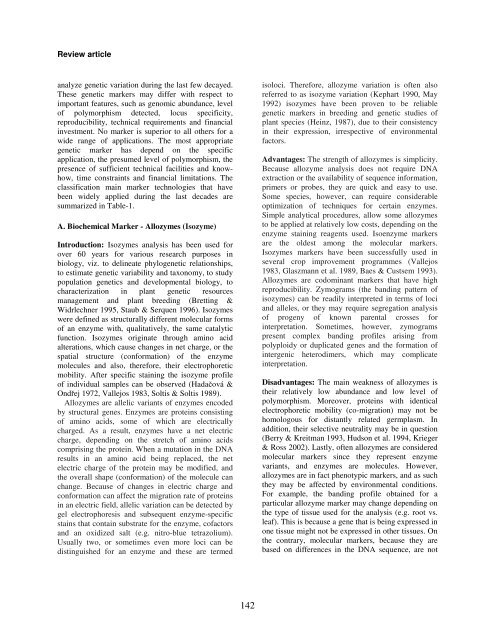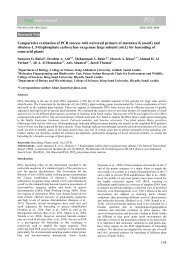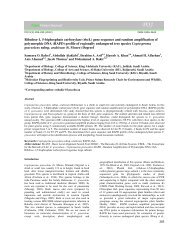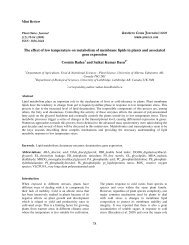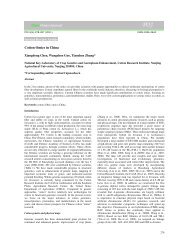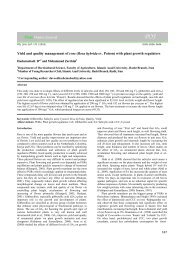Potential of Molecular Markers in Plant Biotechnology - ResearchGate
Potential of Molecular Markers in Plant Biotechnology - ResearchGate
Potential of Molecular Markers in Plant Biotechnology - ResearchGate
Create successful ePaper yourself
Turn your PDF publications into a flip-book with our unique Google optimized e-Paper software.
Review article<br />
analyze genetic variation dur<strong>in</strong>g the last few decayed.<br />
These genetic markers may differ with respect to<br />
important features, such as genomic abundance, level<br />
<strong>of</strong> polymorphism detected, locus specificity,<br />
reproducibility, technical requirements and f<strong>in</strong>ancial<br />
<strong>in</strong>vestment. No marker is superior to all others for a<br />
wide range <strong>of</strong> applications. The most appropriate<br />
genetic marker has depend on the specific<br />
application, the presumed level <strong>of</strong> polymorphism, the<br />
presence <strong>of</strong> sufficient technical facilities and knowhow,<br />
time constra<strong>in</strong>ts and f<strong>in</strong>ancial limitations. The<br />
classification ma<strong>in</strong> marker technologies that have<br />
been widely applied dur<strong>in</strong>g the last decades are<br />
summarized <strong>in</strong> Table-1.<br />
A. Biochemical Marker - Allozymes (Isozyme)<br />
Introduction: Isozymes analysis has been used for<br />
over 60 years for various research purposes <strong>in</strong><br />
biology, viz. to del<strong>in</strong>eate phylogenetic relationships,<br />
to estimate genetic variability and taxonomy, to study<br />
population genetics and developmental biology, to<br />
characterization <strong>in</strong> plant genetic resources<br />
management and plant breed<strong>in</strong>g (Brett<strong>in</strong>g &<br />
Widrlechner 1995, Staub & Serquen 1996). Isozymes<br />
were def<strong>in</strong>ed as structurally different molecular forms<br />
<strong>of</strong> an enzyme with, qualitatively, the same catalytic<br />
function. Isozymes orig<strong>in</strong>ate through am<strong>in</strong>o acid<br />
alterations, which cause changes <strong>in</strong> net charge, or the<br />
spatial structure (conformation) <strong>of</strong> the enzyme<br />
molecules and also, therefore, their electrophoretic<br />
mobility. After specific sta<strong>in</strong><strong>in</strong>g the isozyme pr<strong>of</strong>ile<br />
<strong>of</strong> <strong>in</strong>dividual samples can be observed (Hadačová &<br />
Ondřej 1972, Vallejos 1983, Soltis & Soltis 1989).<br />
Allozymes are allelic variants <strong>of</strong> enzymes encoded<br />
by structural genes. Enzymes are prote<strong>in</strong>s consist<strong>in</strong>g<br />
<strong>of</strong> am<strong>in</strong>o acids, some <strong>of</strong> which are electrically<br />
charged. As a result, enzymes have a net electric<br />
charge, depend<strong>in</strong>g on the stretch <strong>of</strong> am<strong>in</strong>o acids<br />
compris<strong>in</strong>g the prote<strong>in</strong>. When a mutation <strong>in</strong> the DNA<br />
results <strong>in</strong> an am<strong>in</strong>o acid be<strong>in</strong>g replaced, the net<br />
electric charge <strong>of</strong> the prote<strong>in</strong> may be modified, and<br />
the overall shape (conformation) <strong>of</strong> the molecule can<br />
change. Because <strong>of</strong> changes <strong>in</strong> electric charge and<br />
conformation can affect the migration rate <strong>of</strong> prote<strong>in</strong>s<br />
<strong>in</strong> an electric field, allelic variation can be detected by<br />
gel electrophoresis and subsequent enzyme-specific<br />
sta<strong>in</strong>s that conta<strong>in</strong> substrate for the enzyme, c<strong>of</strong>actors<br />
and an oxidized salt (e.g. nitro-blue tetrazolium).<br />
Usually two, or sometimes even more loci can be<br />
dist<strong>in</strong>guished for an enzyme and these are termed<br />
isoloci. Therefore, allozyme variation is <strong>of</strong>ten also<br />
referred to as isozyme variation (Kephart 1990, May<br />
1992) isozymes have been proven to be reliable<br />
genetic markers <strong>in</strong> breed<strong>in</strong>g and genetic studies <strong>of</strong><br />
plant species (He<strong>in</strong>z, 1987), due to their consistency<br />
<strong>in</strong> their expression, irrespective <strong>of</strong> environmental<br />
factors.<br />
Advantages: The strength <strong>of</strong> allozymes is simplicity.<br />
Because allozyme analysis does not require DNA<br />
extraction or the availability <strong>of</strong> sequence <strong>in</strong>formation,<br />
primers or probes, they are quick and easy to use.<br />
Some species, however, can require considerable<br />
optimization <strong>of</strong> techniques for certa<strong>in</strong> enzymes.<br />
Simple analytical procedures, allow some allozymes<br />
to be applied at relatively low costs, depend<strong>in</strong>g on the<br />
enzyme sta<strong>in</strong><strong>in</strong>g reagents used. Isoenzyme markers<br />
are the oldest among the molecular markers.<br />
Isozymes markers have been successfully used <strong>in</strong><br />
several crop improvement programmes (Vallejos<br />
1983, Glaszmann et al. 1989, Baes & Custsem 1993).<br />
Allozymes are codom<strong>in</strong>ant markers that have high<br />
reproducibility. Zymograms (the band<strong>in</strong>g pattern <strong>of</strong><br />
isozymes) can be readily <strong>in</strong>terpreted <strong>in</strong> terms <strong>of</strong> loci<br />
and alleles, or they may require segregation analysis<br />
<strong>of</strong> progeny <strong>of</strong> known parental crosses for<br />
<strong>in</strong>terpretation. Sometimes, however, zymograms<br />
present complex band<strong>in</strong>g pr<strong>of</strong>iles aris<strong>in</strong>g from<br />
polyploidy or duplicated genes and the formation <strong>of</strong><br />
<strong>in</strong>tergenic heterodimers, which may complicate<br />
<strong>in</strong>terpretation.<br />
Disadvantages: The ma<strong>in</strong> weakness <strong>of</strong> allozymes is<br />
their relatively low abundance and low level <strong>of</strong><br />
polymorphism. Moreover, prote<strong>in</strong>s with identical<br />
electrophoretic mobility (co-migration) may not be<br />
homologous for distantly related germplasm. In<br />
addition, their selective neutrality may be <strong>in</strong> question<br />
(Berry & Kreitman 1993, Hudson et al. 1994, Krieger<br />
& Ross 2002). Lastly, <strong>of</strong>ten allozymes are considered<br />
molecular markers s<strong>in</strong>ce they represent enzyme<br />
variants, and enzymes are molecules. However,<br />
allozymes are <strong>in</strong> fact phenotypic markers, and as such<br />
they may be affected by environmental conditions.<br />
For example, the band<strong>in</strong>g pr<strong>of</strong>ile obta<strong>in</strong>ed for a<br />
particular allozyme marker may change depend<strong>in</strong>g on<br />
the type <strong>of</strong> tissue used for the analysis (e.g. root vs.<br />
leaf). This is because a gene that is be<strong>in</strong>g expressed <strong>in</strong><br />
one tissue might not be expressed <strong>in</strong> other tissues. On<br />
the contrary, molecular markers, because they are<br />
based on differences <strong>in</strong> the DNA sequence, are not<br />
142


